A Bit of Purple Heaven
Ingredients:
5 stems dark purple lilacs (Syringa vulgaris), grown by Sunshine Crafts and Flowers

Ingredients:
5 stems dark purple lilacs (Syringa vulgaris), grown by Sunshine Crafts and Flowers
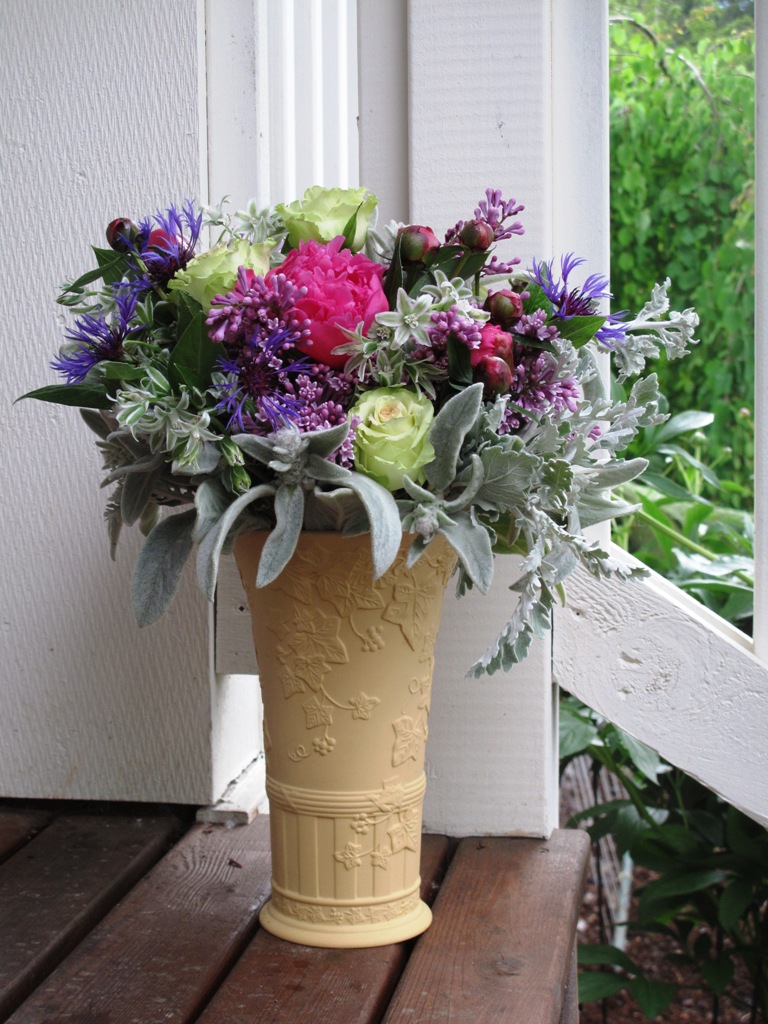
I created this bouquet as a birthday gift for my friend Carrie Krueger. The soft and feminine
gathering of blooms, paired with a vintage butter-yellow Wedgwood Jasperware trumpet vase, makes a complete package.
There’s a lot of wisdom to be found in the Dining pages of today’s New York Times. Mark Bittman’s “The Flexitarian” column focuses on changing our relationship with meat, learning to eat less and re-thinking our food dollar.
You can basically take the term MEAT and replace it with FLOWERS to come up with a very credible explanation about what America’s flower farmers are up against. You know, that notion recently shared by none other than our nation’s Vice President Joe Biden about how cheap, imported flowers are “good for U.S. consumers.” No, Mr. Vice President, they are not. Cheap anything has a huge price. In the case of flowers, if you believe that cheap flowers are good, that means you aren’t concerned about living wage farm jobs in the U.S., about preserving farm land or about encouraging rural economic development. So there is a price to pay. For food writer Mark Bittman, the story of meat gives me a great analogy for flowers. I’ve taken the liberty of changing his story so you can see what I mean. Read on. . .
I feel best when buying from a farmer or farmer’s representative I know, or think I know. But even assuming this is possible, it has what at first appears to be a decided drawback: cost. It’s difficult to nail down averages, but if commodity meat (FLOWERS) — I’m talking about red meat (ROSES) here, but most of what follows could be argued about almost any product — costs something under $10 a pound (PER DOZEN) in most cases, and national brands from humanely treated animals like that from Niman Ranch or Coleman Natural (DOMESTICALLY PRODUCED FLOWERS) cost maybe twice as much, meat GARDEN ROSES from local farmers costs considerably more. It’s not uncommon to spend $25 or more a pound (A DOZEN) on beef (FLOWERS LIKE ROSES) from a trustworthy DOMESTIC source.
The immediate response that we as consumers have to this is “ouch.” Counterintuitive as it may seem, this is good for everyone.
Relatively large-scale sustainable and “natural” or “organic” or “humane” farmers might raise 500 pigs (UNDER 10 ACRES OF FLOWERS) in a year— they are not getting rich. We want these farmers to earn a living; they are stewarding the land in a manner we appreciate and they are providing us with the kind of food (FLOWERS) we want to eat (ENJOY, GIVE TO LOVED ONES, BRING INTO OUR HOMES); they are not using antibiotics (CHEMICALS) routinely or torturing animals (DAMAGING THE ENVIRONMENT). Nor are they likely to be receiving, directly or indirectly, federal subsidies. And they are providing us with meat (FLOWERS) that tastes better (ARE HEALTHIER, FRESHER, LOCAL AND SUSTAINABLE).
All of which may not make up for spending $30 instead of $15. But there are other reasons you can live with these higher prices.
It’s widely accepted that large quantities of red meat may be problematic, health-wise , and
We know that many people have made it a goal to eat less meat (CONSUME DOMESTIC FLOWERS) because large-scale industrial FACTORY FLOWER production is damaging to the environment. This is to a great extent what flexitarianism BEING A LOCAFLOR is about, after all.
Here’s a way to think about it: The price of food in general is what economists call “inelastic” — you’re going to eat something no matter the cost. But The price of any particular food like meat (FLOWER) is elastic — you will buy less as it becomes more expensive. Though it may at first seem paradoxical, this is a good thing from nearly every perspective.
I am saying this: Spend the same $30, or $50 or $100 or $300 on meat FLOWERS that you now spend each week or month, but buy less and buy better. You might compare this to an annual purchase of 20 $5 T-shirts made bychild labor (CHEAP, IMPORTED FLOWERS GROWN BY LOW-COST LABOR) versus one of five $20 T-shirts (BOUQUETS) made by better-paid and better-treated workers from organic cotton AMERICAN FLOWER FARMS. Expensive meat from real farms is a more extreme example of this less-is-better policy.
I hope you can follow where I’m going with this word-play. The takeaway message to me is that American Grown flowers might cost more, but they are higher quality, they will last longer, AND, they are sustaining American flower farms.
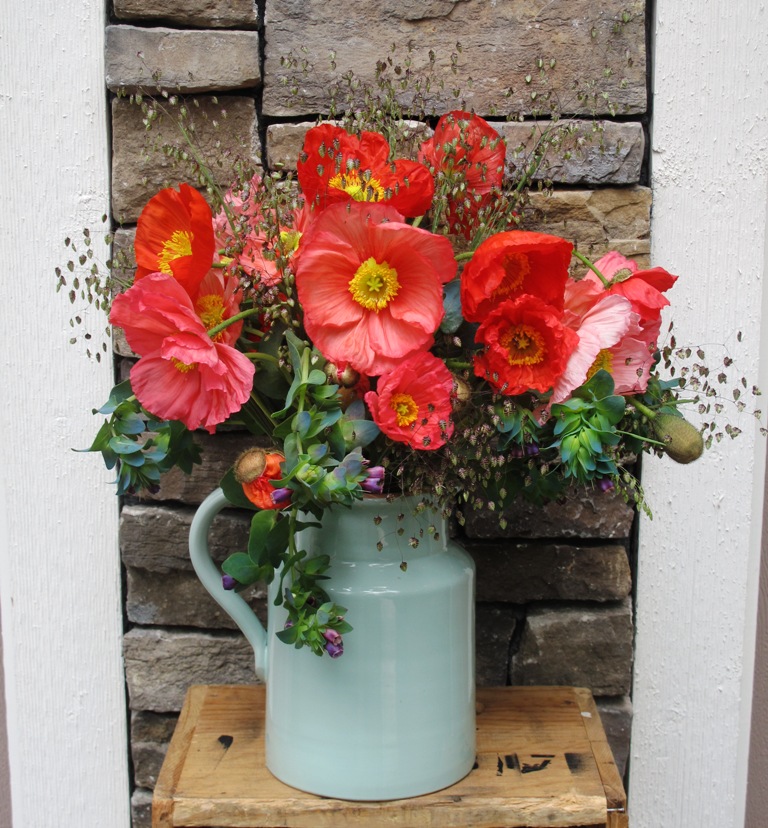
Why do we love poppies so much? Perhaps it’s because of their pure, vibrant petal colors with the charming button-like centers.
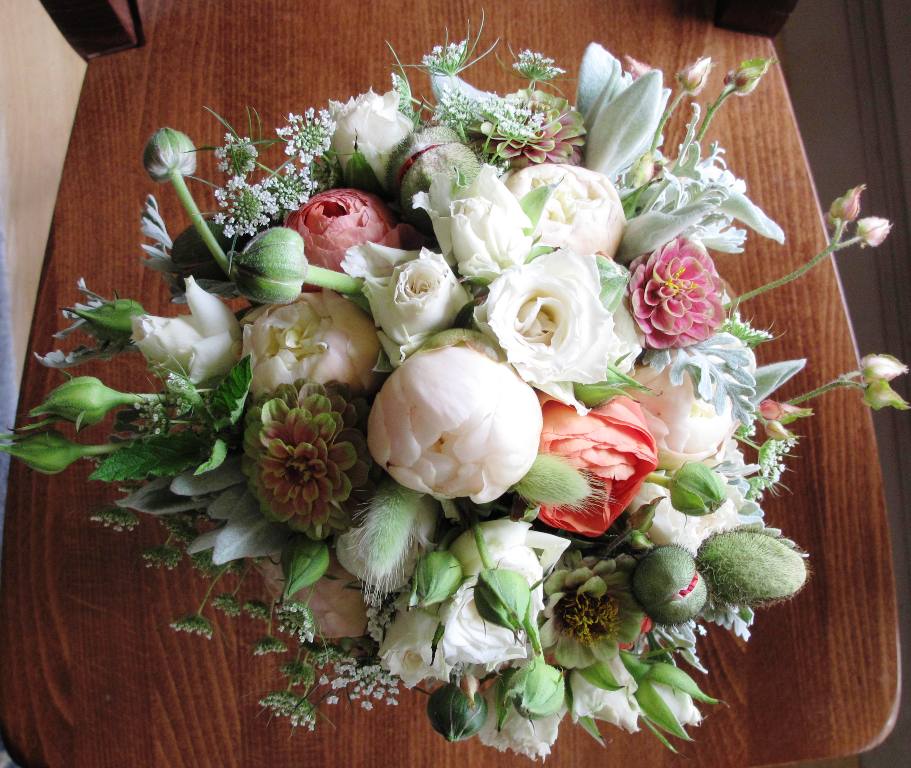
Tight flower heads, soft foliage that doesn’t bruise easily, and interesting textural elements – add up to a wedding bouquet for a friend far away.
A dear friend of mine is getting married today, in a state halfway across the country. None of her close friends are there to support her, mostly because she only recently moved away from Seattle to be close to her sweetheart. But at least she’s going to hold a bouquet of flowers I made Wednesday and sent via FedEx overnight delivery service. Her new husband will be wearing a sweet little boutonniere I sent along.
Here’s how to successfully make and send a long-distance gift of flowers:
1. Select durable flowers with fairly tight buds. I chose all Northwest-grown flowers in a cream-to-peach-to-coral palette:
READ MORE…
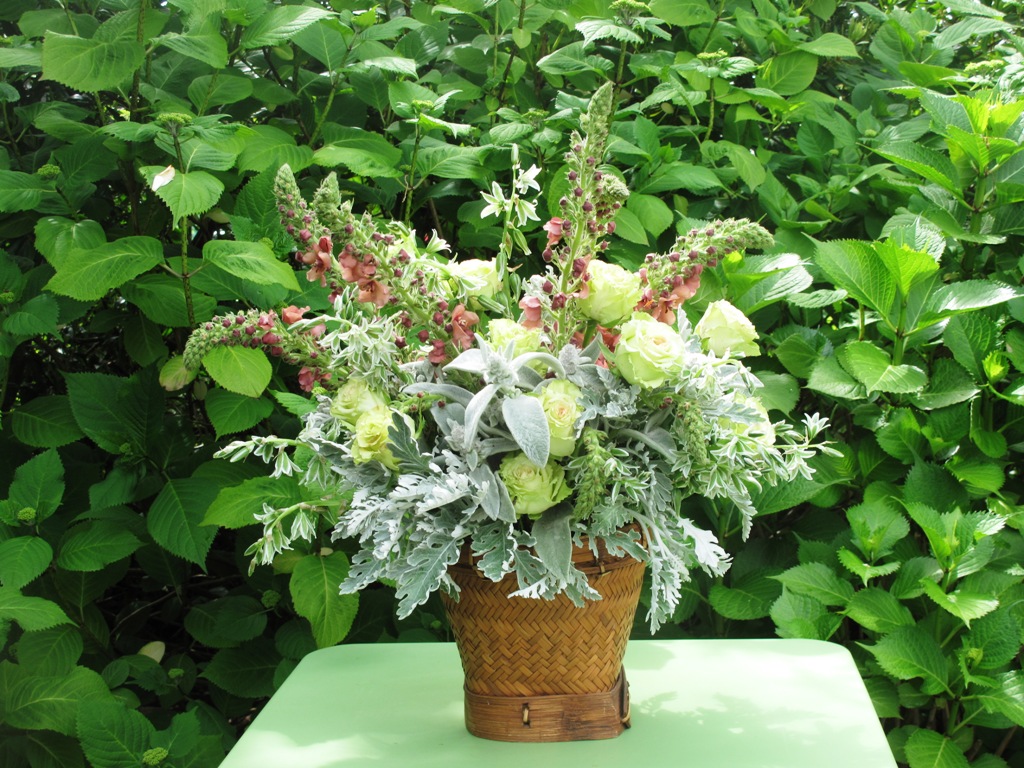
An unexpected combination, inspired by the pale ‘Supergreen’ hybrid tea roses given to me by the grower
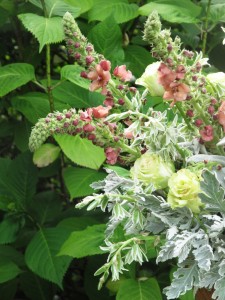
This sweet detail shows the delicate features of the apricot verbascum and the varietgated Star of Bethlehem
Ingredients:

Field-grown peonies should be selected at the “marshmallow” stage, when the heads have just a little give when squeezed.
Forget flowers grown far from home. You’ll find the best blooms right in your own neighborhood – straight from a local flower farmer.
The growth of local farmers’ markets is staggering – up 17 percent nationwide in 2011, according to the USDA (USDA Farmers’ Market Data). And as more farmers’ markets establish in communities across the U.S., you can be certain to find more beautiful flower stalls, which is great news for the DIY floral designer, hostess and nature- lover.
When you shop at a weekly farmers’ market, look for fresh, seasonal and uncommon floral crops – you’ll be wowed by the selection and quality. Yes, it’s fun to meet the people who grow these blooms. But you can also learn from their experience and knowledge — ask your flower farmer for tips on how to care for their beautiful stems at home. Here are some of the best ways to enjoy farmers’ market flowers and extend their vase life:
Selection: Most farmers harvest their crops as close to market day as possible, ensuring very fresh varieties – straight from the field. Shop early in the morning for the best choice (plus, flowers are always happier when it’s cooler!). If the market is in an uncovered location, expect to see large awnings or umbrellas to keep the floral products out of direct sun. Look at the stall’s hygiene – are the buckets clean and filled with fresh water? Be sure to ask “Where is your farm?” and “Why type of growing practices do you use?” – let the vendor know you appreciate sustainable practices.
What to look for:
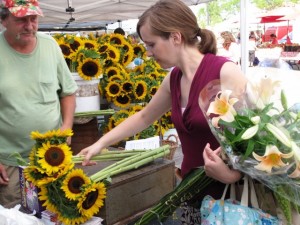
Chicago floral designer Lynn Fosbender, owner of Pollen Flowers, relies on Midwest flower farmers for her summertime vase arrangements and bouquets.
When choosing a mixed bouquet, look at all the ingredients to see that they are equally fresh. The focal flowers, softly-textured delicate elements and foliage should feel plump; not wilted or limp. When selecting a straight bunch, often called a “grower’s bunch,” check that all the stems are similar in length and all the blooms are similar size.
READ MORE…
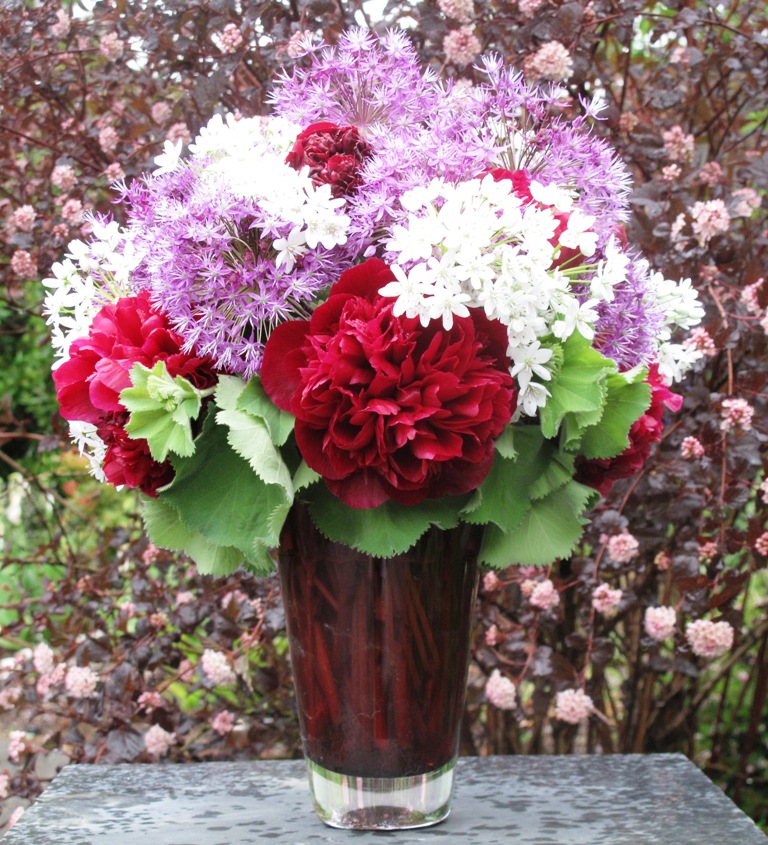
These luscious red peonies from a local grower reflect the garnet-colored art glass and complement two forms of ornamental allium.
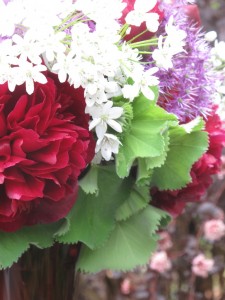
The lady’s mantle foliage is absolutely the BEST for spring bouquets. And if your garden is like mine, it’s super abundant right now!
Ingredients:
10 stems red peonies, grown by Ojeda Farms
7 stems each ‘Purple Sensation’ and ‘Cowanii’ ornamental alliums, grown by Choice Bulb Farms
12 stems lady’s mantle foliage (Alchemilla mollis), harvested from my garden
Vase:
9-inch tall x 5-inch diameter hand-blown glass vase
Design 101
Create a collar: You can use flowers or foliage to ring the base of a bouquet or arrangement as a finishing detail. This technique is usually done as the bouquet’s last step. For this arrangement, I pre-cut the greenery and then added it beneath the peonies, slightly overlapping each stem as I worked around the circumference of the bouquet. Here, the lady’s mantle visually separates the dark red peonies from the wine-red vase.
Lots of news to share, including this very timely interview that Seattle’s NPR station KPLU-FM aired today. Environment reporter Bellamy Pailthorp contacted me to discuss “sustainable flowers for Mother’s Day,” and thanks to her incredible interviewing and editing talents, a 25-minute conversation turned into a 4-1/2 minute segment. You can listen to it here.
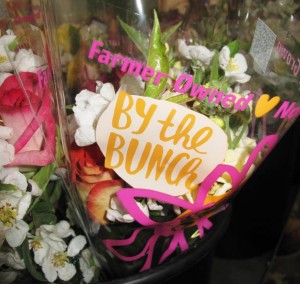
Remember this cool logo: By the Bunch. It means these gorgeous bouquets are possible because their ingredients were grown by a bunch of awesome NW flower farmers
The interview gave me a chance to talk about the excitement at the Seattle Wholesale Growers Market – a just-launched supermarket bouquet program called “By the Bunch.” The beauty of this program is that it produces a sizeable income stream for every farmer-member at the SWGM Cooperative. Together they are so much more than the sum of their parts (or their flower fields, for that matter).
Today, the Thursday before Mother’s Day, was perhaps the most insane work day ever experienced by the Bouquet team, including managers Kristen Parris and Nicole Cordier, along with their new design team members, Carly and Michelle.
But in order to produce a staggering number of bouquets today – something like 700 bunches – flower farmers Diane Szukovathy and Vivian Larson had to show up and volunteer their time as bouquet-makers. I stopped by at around 9:30 a.m. to catch the activity.
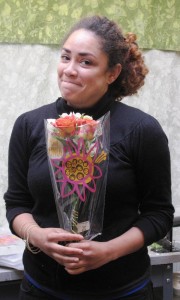
SWGMC Front-Desk Manager, talented designer and inspiring leader for the local flower movement, Nicole Cordier.
Oh, bouquet-making sounds so romantic, doesn’t it? But by 7 p.m., when I had to bring by supplies for a special event tomorrow morning, Kristen and Nicole were still there, finishing up the final 100 bunches. Ever-positive, but clearly exhausted, these women believe so much in getting sustainable and locally-grown blooms into the hands of Seattle area consumers that they are willing to go without food and breaks just to achieve the goal. As I told them: If you can get through Mother’s Day, you can do anything. (They probably didn’t need to hear it from me!)
Read more about the By the Bunch program here. The brand development, graphic design and packaging is supported by a USDA Multi-State Specialty Crop Block Grant through the Washington State Department of Agriculture and the Oregon Department of Agriculture.
My photos from today’s visit will wow you. If you haven’t figured out what to give Mom for her special day on Sunday, May 12th, stop by these outlets for LOCAL, SEASONAL Bouquets – straight from Northwest fields: PCC Natural Markets, Town & Country Markets and Madison Market.
My camera snatched some of today’s delicious springtime beauty to share:
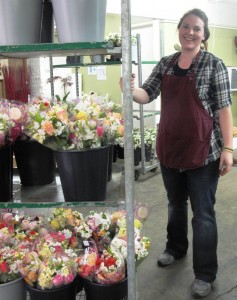
At 9:30 a.m. today, Michelle was ready to wheel an entire cart of bunches into the cooler. So exciting to have her on the SWGMC team!
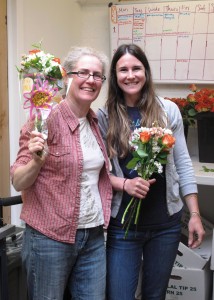
A moment to smile, and who wouldn’t? Creating bouquets for Mother’s Day is a special job – and Diane Szukovathy of Jello Mold Farm (and SWGMC president) was on hand to help designer Carly and the rest of the team this morning.
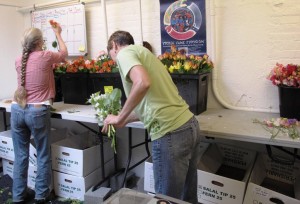
Two of the founding farmers of SWGMC, Diane Szukovathy and Vivian Larson, spent the morning making bouquets with the team.
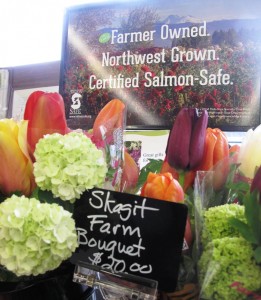
Later this morning I stopped by my local PCC Natural Market to see the By the Bunch floral display. Gotta love this messaging~
For every mother out there, HAPPY MOTHER’S DAY ~ and may you enjoy your garden, your flowers and your families.
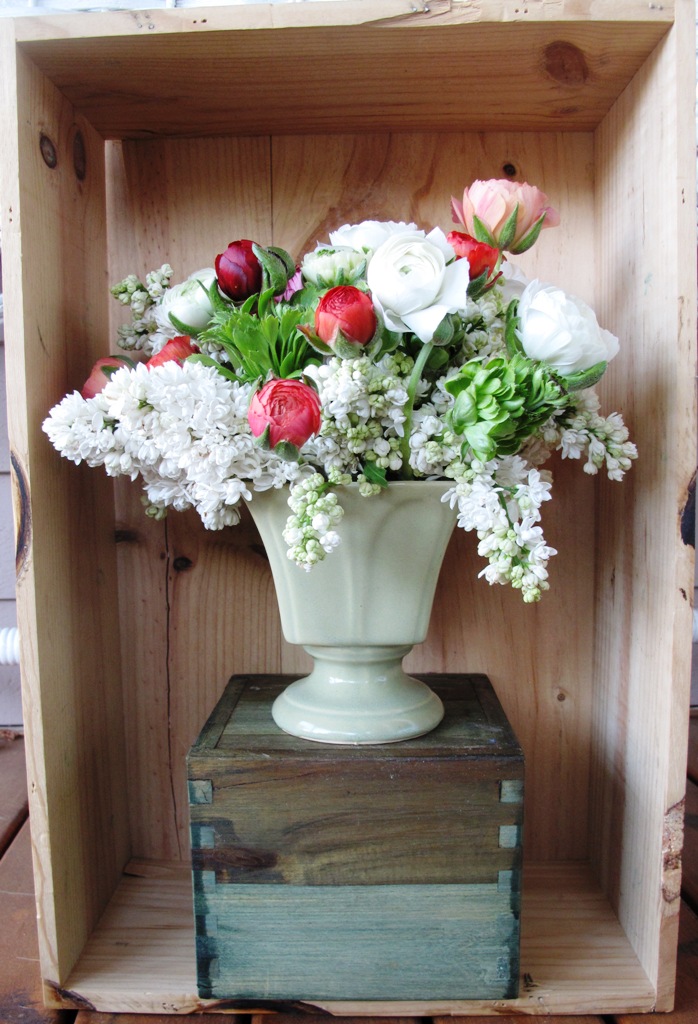
A wine crate serves as a shadowbox for this sweet spring bouquet of white lilacs and ranunculus in a bright pastel palette.
Ingredients:
10 stems lilac (Syringa vulgaris), grown by Oregon Coastal Flowers
12 stems Ranunculus asiaticus, including ‘La Belle’ and ‘Super Green’ varieties, grown by Everyday Flowers
Vase:
5-inch tall x 5-inch wide x 3-inch deep vase (overall height is 5½ inches)
From the Farmer
Extending the vase life: For decades, it’s been the conventional wisdom of florists that woody shrubs, such as lilacs and hydrangeas, benefit from a second cut, a vertical slice up the center of the stem, to increase the surface area that can absorb water. But according to professors Lane Greer and John M. Dole, authors of Woody Cut Stems for Growers and Florists, a research-based reference, the practice “has never been proven to extend vase life.” The best thing you can do is to use clean, sharp pruners and refresh the vase water every day or so.
© Debra Prinzing, all written and photographic content. Website design/development by Willo Bellwood/Metric Media